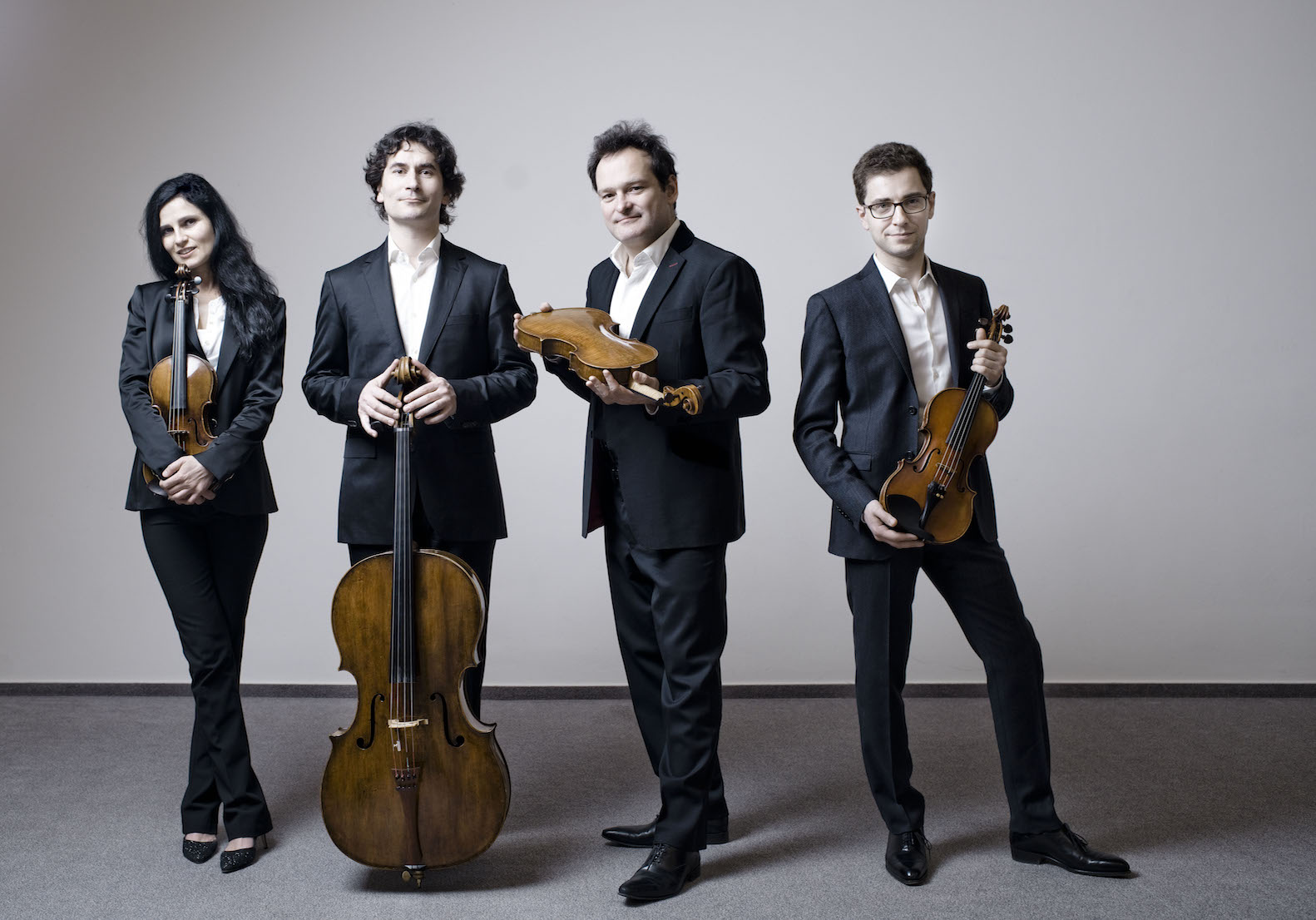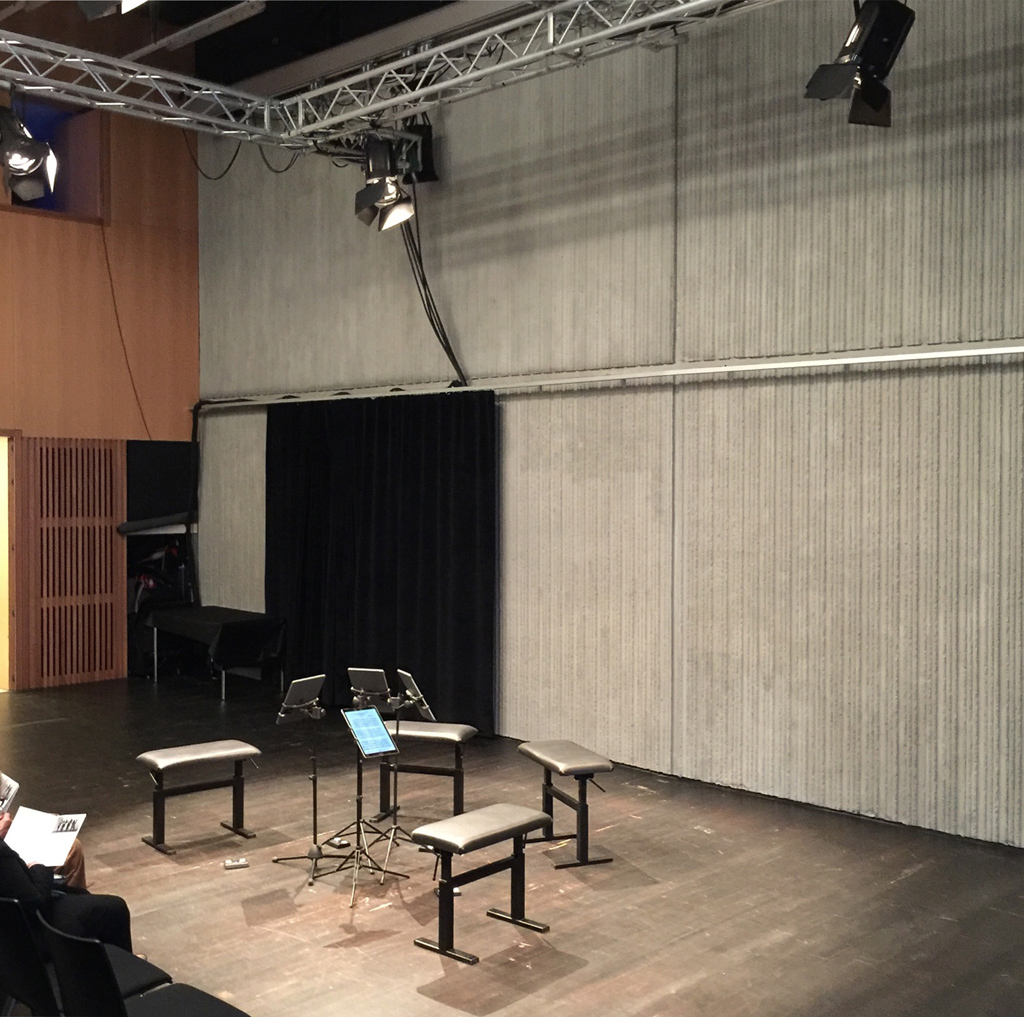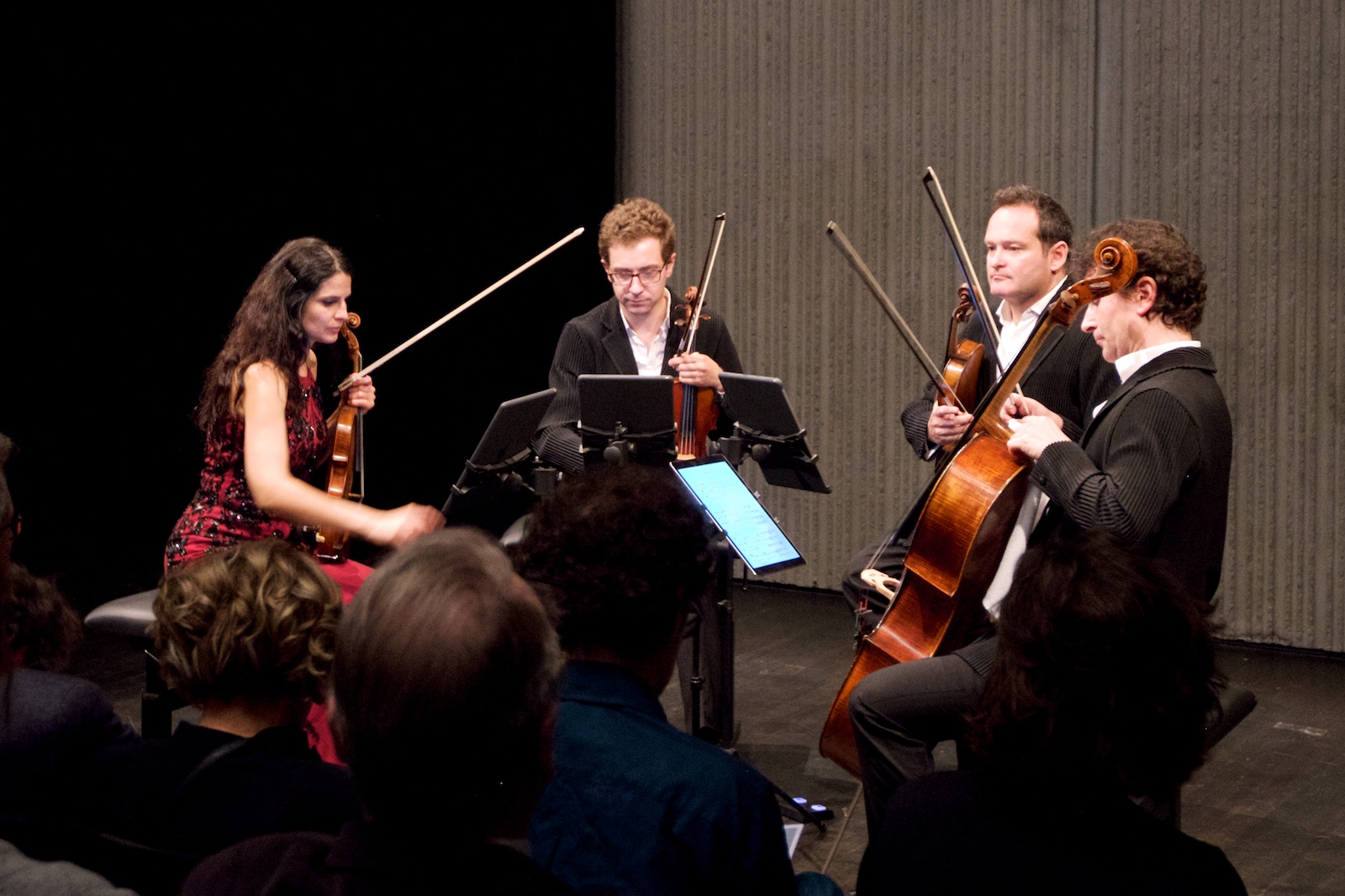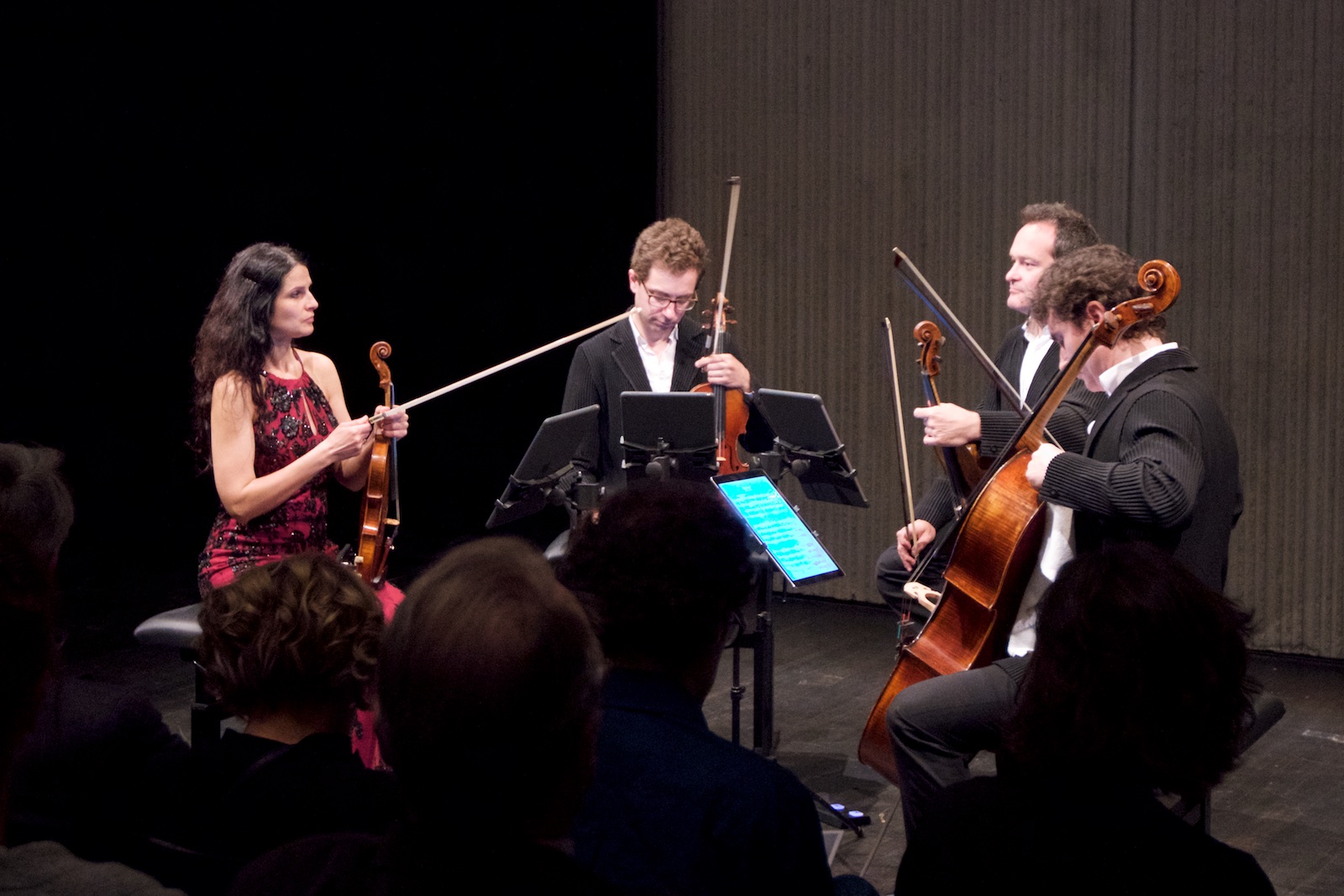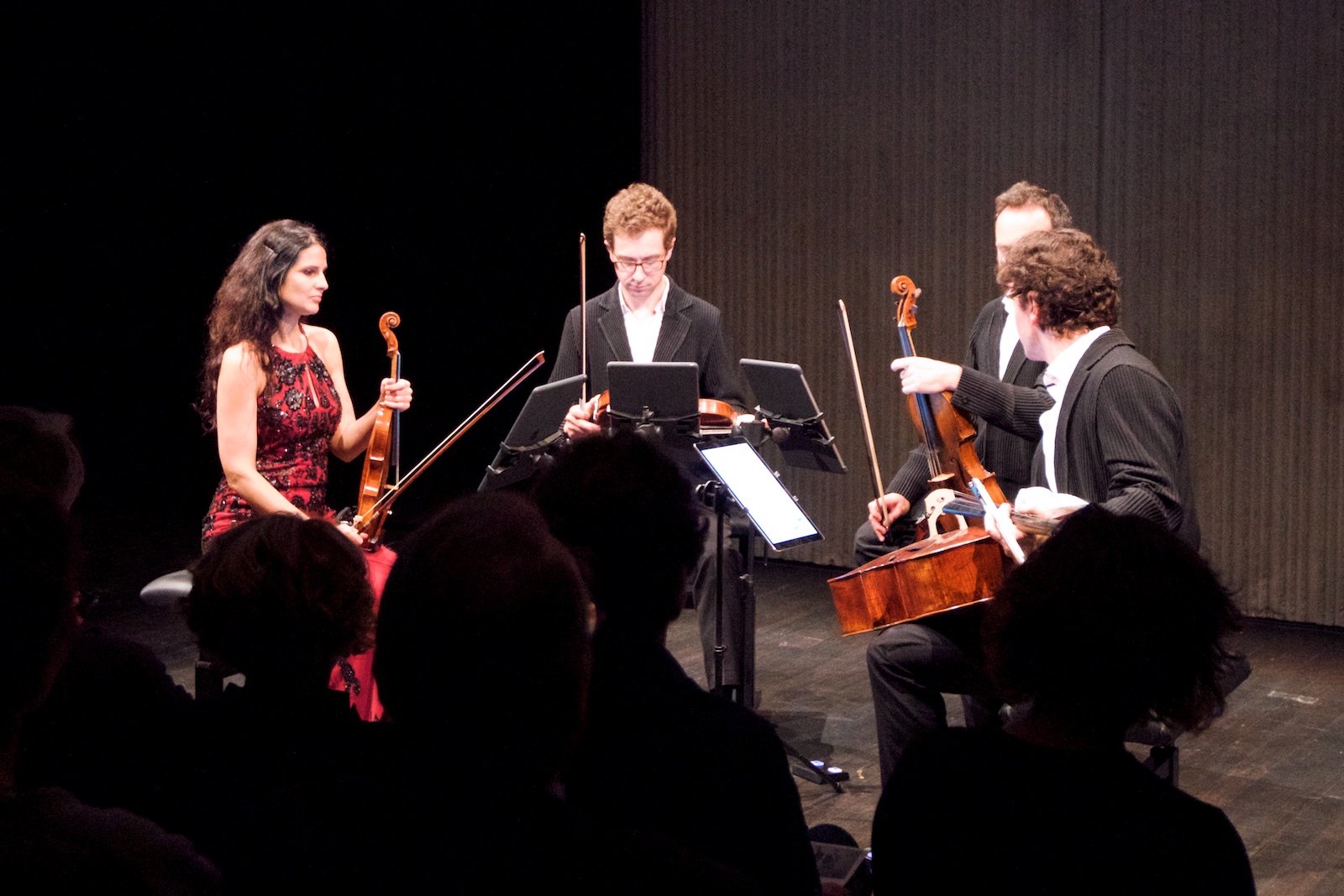Belcea Quartet
Haydn / Ligeti / Dvořák
Lugano, LAC / Teatrostudio, 2018-04-20

2018-04-28 — Original posting
2020-01-03 — Few text rearrangements, outline added
2023-09-09 — Addendum about staff change
Table of Contents
- Introduction
- The Venue
- Setup
- Interactions
- Sound
- Haydn: String Quartet in D major, op.20/4, Hob.III/34
- Ligeti: String Quartet No.1, “Métamorphoses nocturnes”
- The Performance
- I. Allegro grazioso —
- II. Vivace, capriccioso — III. A tempo —
- IV. Adagio, mesto —
- V. Presto – Prestissimo —
- VI. Molto sostenuto – Andante tranquillo —
- VII. Tempo di Valse, moderato, con eleganza, un poco capriccioso —
- VIII. Più mosso — IX. Subito prestissimo —
- X. Subito: molto sostenuto —
- XI. Allegretto, un poco gioviale — XII. Allargando Poco più mosso — XIII. Subito allegro con moto, stringendo poco a poco sin al prestissimo — XIV. Prestissimo —
- XV. Allegro comodo, gioviale — XVI. Sostenuto, accelerando – Ad libitum, senza misura — XVII. Lento
- Summary
- The Performance
- Dvořák: String Quartet No.12 in F major, op.96, “American”
- Encore 1 — Beethoven: 5. Cavatina , from the String Quartet No.13 in B♭ major, op.130
- Encore 2 — Shostakovich: 3. Allegro non troppo , from the String Quartet No.3 in F major, op.73
- Conclusion
- Addendum
Introduction
The violinist Corina Belcea founded the Belcea Quartet in 1994, then at the Royal College of Music in London. The quartet includes the following musicians and nationalities
- Corina Belcea-Fisher, violin (Romania, 1994 / founding member)
- Axel Schacher, violin (Switzerland / France, since 2010)
- Krzysztof Chorzelski, viola (Poland, since 1996)
- Antoine Lederlin, cello (France, since 2006)
For additional information see also Wikipedia.
I have reported about a recent concert of the Belcea Quartet, in Zurich, on 2018-02-04 — for additional information see that concert review. The program for the concert in February closed with the same composition as this one, the “American” Quartet by Dvořák. My earlier report on that had been somewhat critical. I therefore felt it may be worthwhile to give them a second chance on this, in a different environment / setting.
The Venue
After a year (see the reports on the concerts on 2017-04-21, 2017-04-22, and 2017-04-23) this was a return to the Teatrostudio within the LAC (Lugano Arte e Cultura) in Lugano, for another series of three string quartet concerts on three consecutive days. The “Teatrostudio” a small, rectangular hall with “technical” looks, parts of the walls and the window covered with black curtains. It’s all the same as a year ago, except that the audience (72 seats, around 60 people in the audience) and artists now swapped positions.
Apart from the dark curtains, the lighting during the performance was on the artists only, with the audience sitting in almost total darkness: a pity for those who might have wanted to have a look at the program notes. Luckily, I had the scores on my iPad (almost completely dimmed down, of course); I wrote my sketchy notes (keywords only, really) almost blind-folded.
Setup
With all four artists playing from a tablet rather than sheet music, the quartet could form a much closer semi-circle than what we see normally in such concerts. Corina Belcea-Fisher at the first violin was facing Antoine Lederlin at the cello, Axel Schacher (violin 2) and Krzysztof Chorzelski (viola) both faced the audience. For the Haydn quartet only, the artists were playing with classic (rather than modern “Tourte“) bows, but the strings were definitely modern (not gut strings).
Interactions
A “direct link” seemed to connect Antoine Lederlin and Corina Belcea, the founder and clear leader of the ensemble, pulling all the strings (her being the only woman, and the color of her dress both reinforced the impression of dominance, at least optically). These two artists would rarely ever look into the audience: while playing, they didn’t seem to take notice of the listeners.
It may have been in the compositions, but the two members in the rear often appeared to act jointly, interacting both mutually and with the audience (at least passively), while constantly keeping an eye on the first violin and occasionally also on the cellist. Essentially, the ensemble formed a “closed circle”, with 100% focus on the music they were playing—four professionals with years of common experience, and with a full understanding of their jointly agreed intentions and views.
Sound
I was most pleased to see and hear that the artists not only played with classic bows, but also almost completely without vibrato. This yielded the maximum in clarity, both in intonation and articulation. The classic bows may also have been helpful in avoiding Nachdrücken, unwanted “belly notes”, and the like.
This small venue probably highlighted differences in sound characteristics and quality between the instruments. It is unlikely that the venue gave any advantage to the two front players (especially as—different from the viola and the second violin—these two were not facing the audience), but I felt that the sound of the first violin often dominated (certainly in volume, but also in quality / definition of the sound), followed by the cello (which per se offers plenty of volume). To me, the sound of the second violin and of the viola had slightly nasal characteristics (in contrast to the other two instruments), at least in the Haydn quartet.
Haydn: String Quartet in D major, op.20/4, Hob.III/34
The six string quartets op.20 played a key role in establishing Franz Joseph Haydn (1732 – 1809) as creator / inventor of the genre. He composed these quartets around 1772, while working for the Prince Nikolaus Esterhazy. For more information see my report about a concert with this composition last fall, in Zurich, on 2017-10-08. The composition features the following movements:
- Allegro du molto (3/4)
- Un poco Adagio affettuoso (2/4) — Var.I – IV
- Menuetto: Allegretto alla zingarese (3/4) — Trio (3/4)
- Presto scherzando (4/4)
The Performance
The venue also seemed to enhance / increase dynamic contrasts—an effect which later worked very much in favor of the performance in the Ligeti quartet.
I. Allegro di Molto
The ensemble exhibited fluent, clear articulation, the warm tone of the ensemble (despite the modern strings). Vibrato was used very rarely—and mostly in the development part only. I liked the extreme pp at the beginning of the recap section!
Part of what engaged me as a listener was the vivid body language of the middle voices (violin 2, viola) in the rear.
II. Un poco Adagio Affettuoso
A word on articulation. I mostly noted this with the first violin, where I found that the artist was giving a slight preference on the longer notes (which helped her dominating the sound), while small notes (e.g., in punctuated pairs) were almost treated as ornaments. I also noted that in the theme (both parts repeated), the affettuoso was taken as “excuse” for additional (well-fitting) ornaments, not just in the repeat, but also in the first pass. No objections at all here—quite to the contrary!
Variation 1: excellent, swaying agogic play, even more so in variation 2, mostly controlled by the cello: excellent! In variation 3 (dolce), the violin takes back the control over the rubato, this time at an appropriate, slightly faster pace. Variation 4 started with excellent sotto voce playing, followed by two waves of crescendo to f. After a short ff outburst, a cadenza-like in the violin leads to a short coda with syncopes—and into an almost sudden, silent ending. Throughout the movement, I enjoyed how the lead instrument (mostly violin 1 and cello, occasionally also violin 2) took its time to play out the highlights in their respective phrases.
III. Allegretto alla zingarese
A true, wild, almost ferocious alla zingarese: entertaining, fun! The Trio was presented as distinctly contrasting, also at a slower tempo. Here, for once (from the score, of course), the cello took the clear lead. I enjoyed the lively agogics & the extra ornaments in the repeat part.
IV. Presto scherzando
My main quibble here: at the selected, very fluent pace, small note values (semiquavers, semiquaver triplets) were occasionally bordering on superficiality.
An interesting detail: bars 8 & 9 feature pungent interjections by the first violin, in the form of groups of four double-stop semiquavers C#-F, a diminished fourth: on a piano, this would sound like an ordinary major third. However, here it was a strikingly dissonant interval—especially when played without vibrato. Other ensembles tend to indulge in the fun of playing these f, making them stand out even more. Here, Corina Belcea, played these rather softly. As she was alone, one would of course still notice the interjections. I wondered and checked the score—and indeed: Haydn wanted to have these played p, not f: thanks for rectifying this!
According to my score, the quartet completely changed Haydn’s dynamic annotations in the recap section (bars 86ff), almost changed them to the opposite. This made me wonder about the reason behind the change…
Rating: ★★★★
Ligeti: String Quartet No.1, “Métamorphoses nocturnes”
György Ligeti (1923 – 2006) wrote his String Quartet No.1, called “Métamorphoses nocturnes” in 1953/1954. This was before the composer fled Hungary in 1956. Ligeti apparently called this the “prehistoric Ligeti”—a period strongly influenced by Béla Bartók (1881 – 1945). The work is in one single, continuous movement with 17 distinct sections:
- Allegro grazioso
- Vivace, capriccioso
- A tempo
- Adagio, mesto
- Presto – Prestissimo
- Molto sostenuto – Andante tranquillo
- Tempo di Valse, moderato, con eleganza, un poco capriccioso
- Più mosso
- Subito prestissimo
- Subito: molto sostenuto
- Allegretto, un poco gioviale
- Allargando Poco più mosso
- Subito allegro con moto, stringendo poco a poco sin al prestissimo
- Prestissimo
- Allegro comodo, gioviale
- Sostenuto, accelerando – Ad libitum, senza misura
- Lento
The Performance
Here, of course (and throughout the rest of the concert), the artists switched to modern “Tourte” bows. For all I can tell, the Belcea Quartet presented an excellent performance of Ligeti’s first string quartet. Given the absence of a score, my comments on the performance are interspersed with remarks just describing the music.
I. Allegro grazioso —
At the beginning, I briefly listened up when I was looking for Ligeti’s “self-quote” (or rather: the anticipation) of the piano study “L’Escalier du diable”, a dissonant, “endless” ascending scale in the accompaniment. I was initially a tad disappointed that this scale was very discreet in this performance. However, with the experience from the last movement in the Haydn quartet, I suspect that this may well be what the score asks for. I didn’t have the score at hand for this performance.
What sprung to mind was that in this first segment, the artists were highlighting the melodic aspects of the composition, with its nice (but fragmentary, though) melody lines. The music grows into a dense climax…
II. Vivace, capriccioso — III. A tempo —
… then we found ourselves in the Vivace, capriccioso segment: vehement, dissonant (of course), percussive, from a single mold in this performance, rhythmically enthralling, fascinating! I liked the flow, the alert playing, the contrasts, the fun! I had the impression of an emotional, rather than cold / analytical performance.
IV. Adagio, mesto —
A short rest leads into a calm, soft segment with a melodious, emotional, lamenting cantilena on the first violin. The cello starts responding to the melody, while the middle instruments initially just set a background with resting notes. The emotions build up to a climax, a new start begins in the middle voices, and suddenly…
V. Presto – Prestissimo —
…we find ourselves in a very virtuosic segment, very strong, powerful: impressive playing! The short Prestissimo section is strongly rhythmic, building up to a strong, loud outburst and almost forceful, rough chords. —
VI. Molto sostenuto – Andante tranquillo —
Melancholic melody fragments, with a background of pp / ppp / pppp trills, interrupted with powerful pizzicato and tremolo interjections. Solemn in the calm parts, but full of tension. Excellent, controlled (but still emotional) playing.
VII. Tempo di Valse, moderato, con eleganza, un poco capriccioso —
A folk dance like waltz segment—more of a caricature, actually: fun also here!
VIII. Più mosso — IX. Subito prestissimo —
The waltz is only a short episode, followed by a wildly rhythmic segment, building up to jazzy syncopes. The Belcea Quartet offers a performance with bite—powerful, almost too loud for this small venue!
X. Subito: molto sostenuto —
Almost inevitably, Ligeti follows up with a very calm segment. All movement appears to stop, except for a very high, but lovely cantilena on the first violin. Throughout the performance, all transitions in rhythm and tempo are 100% firm, perfect.
XI. Allegretto, un poco gioviale — XII. Allargando Poco più mosso — XIII. Subito allegro con moto, stringendo poco a poco sin al prestissimo — XIV. Prestissimo —
Playful, somewhat jazzy, light-hearted melody fragments with wide glissandi. Thereafter, “industrial”, machine-like sounds, rhythmic pounding. Acceleration, strongly ripped, banging pizzicati, with a constant drive / pull forward: Bartók, Shostakovich?? Enthralling, in any case!
XV. Allegro comodo, gioviale — XVI. Sostenuto, accelerando – Ad libitum, senza misura — XVII. Lento
Narrow intervals, mixing between the voices—a swarm of bees? Building up, urging, accelerating, up to a tremolo eruption, then “airy”, eerie tremoli (played sul tasto), counterpoints, interjections in the form of more, strong eruptions. Calming down, a very melodic cello solo. Ultimately, the music fades away into a long, total silence.
Summary
The Belcea Quartet at its best: virtuosic in coordination and dynamic control, covering Ligeti’s extreme dynamic span (from ppppp up to fffff)—using this venue to it’s optimum effect: intimacy and power! Clearly, the best performance in the official program!
Rating: ★★★★½
Dvořák: String Quartet No.12 in F major, op.96, “American”
Antonín Dvořák (1841 – 1904) composed his String Quartet No.12 in F major, op.96 (known as the “American”) 1893,, while he was in the United States (hence the name). The composition overall follows the classic scheme, with four movements:
- Allegro ma non troppo
- Lento
- Molto vivace
- Finale: Vivace ma non troppo
Not too long ago, I have already heard the Belcea Quartet in a performance of Dvořák’s op.96, in a concert on 2018-02-04. Therefore I’m skipping further explanation, and I also keep the comments below short.
The Performance
A thought that sprung to mind: while in the Haydn quartet the outer voices (primarily the first violin) were dominating, the Ligeti quartet presented a uniform, joint effort, and a performance out of a single mold & mind. Here now, the middle voices (second violin and viola) were finally given a chance to show profile, to present the strength and sonority of their instruments and voices.
I. Allegro ma non troppo
The initial bars gave a chance to enjoy the impressive sonority of the viola in its nice cantilena, above a backdrop of pp tremolos. The first violin then takes over the cantilena, the music rapidly gets more lively. Oddly, some of the tension got lost in bars 24ff. It seemed to evolve in waves, was missing at times. One example was the ppp / in tempo in bar 44ff., where the artists did use agogics as part of the phrasing. However, as in their earlier performance, I missed the rhythmic swaying between the bar lines, which I associated with Slavonic music, especially if it is as close to folk tunes as Dvořák’s.
II. Lento
In agogics, I liked the slight broadening around the fp. On the other hand, I again missed the rhythmic swaying. Overall, the performance felt somewhat dry, neutral, and I don’t see why now the vibrato (especially in the first violin) needed to be so strong, and why there were so many glissandi / portamenti: that (alone) does not create “Slavonic atmosphere”.
Technically, the performance was of course very good and really differentiated in the dynamics. But I missed that specific atmosphere which other ensembles are able to create in this movement: I personally would describe this as “fog”, as mystery atmosphere. Somehow, the movement left me untouched: were these missing (or suppressed) emotions on the part of the artists? It’s hard to pinpoint what was missing here. Was there maybe even dynamic over-emphasis that made it feel put-on?
III. Molto vivace
The first part was swinging OK, but then I found a certain tendency for the movement / the musicians to lose momentum. And again, the vibrato in the first violin was very (too) strong. Maybe the dynamics, the emphasis in agogics, the highlighting of climaxes was a tad exaggerated? I missed some subtlety in this piece. Or did it not feel natural enough?
IV. Finale: Vivace ma non troppo
Here, the tempo was at the upper limit, missing the ma non troppo part. But that wasn’t my only quibble: maybe with the fast tempo, the melody (primarily in the first violin) was too clear, did not have enough time for agogic play? I don’t claim it was all played too straight: the melody line was not devoid of “language”, of expression. However, perhaps in trying to squeeze this into a tempo that almost started to feel uncomfortable pushing, the local dynamic emphasis sounded a tad overblown, not natural, folk-like enough? Or was it the strong vibrato, the portamenti that made it feel put-on? As in the earlier performance, I almost completely missed the folk dance in this music. One could briefly say: it wasn’t relaxed enough. Too bad—a missed opportunity.
Summary
I had somehow hoped that this performance would correct my critical findings from the earlier concert two months ago. However, I saw my earlier criticism confirmed—and the blame wasn’t with the venue or the acoustics. I was listening carefully both times, and I did not go into this concert with the goal to confirm my earlier findings!
Rating: ★★★
Encore 1 — Beethoven: 5. Cavatina, from the String Quartet No.13 in B♭ major, op.130
The first encore was the same as in their performance in Zurich on 2018-02-04: the fifth movement, Cavatina, from the String Quartet in B♭ major, op.130 by Ludwig van Beethoven (1770 – 1827). This music rarely fails in touching the listener, showing the composer’s deepest sentiments, instantly provoking commotion.
I can’t complain about the Belcea Quartet’s interpretation here, in general. However, I was somewhat irritated to note that here, the artists kept the modern “Tourte” bows. True, it may take a conscious effort to switch between classic and “Tourte” bows. Even more so, I was somewhat alienated to see that they were playing with a romantic tone, full of vibrato everywhere (except—thankfully—for the very last notes). This left me with a bit of a bitter aftertaste: why? Were they only just playing the Haydn with classic bows because it is fashionable? Did this not come from their heart, their sincere conviction? If it did, didn’t Beethoven deserve the same treatment of a historically informed performance, especially as they have proven to be able to do this so well in the Haydn quartet?
Rating: ★★★
Encore 2 — Shostakovich: 3. Allegro non troppo, from the String Quartet No.3 in F major, op.73
Dmitri Shostakovich (1906 – 1975) wrote his String Quartet No.3 in F major, op.73 in 1946, after his Symphony No.9 in E♭ major, op.70 was censored by the authorities. In order to avoid further trouble, the composer gave the quartet a “program”, a story of war. The third movement, Allegro non troppo carried the title “Forces of war unleashed”.
Luckily, after the somewhat disappointing first encore (disappointing with respect to what this ensemble is capable of achieving), there was an opportunity to correct this impression. And the Belcea Quartet did, by playing the middle movement from Shostakovich’s third string quartet. They once more demonstrated their virtuosity, their huge dynamic scope.
Rating: ★★★★★
Conclusion
An ensemble with very impressive technical power and abilities, highly virtuosic: at the international forefront of quartet playing—with some composers. I see their particular strength with music by 20th century composers such as Ligeti and Shostakovich, where they can play out their power and joint strength. Their Dvořák left me untouched, and the comparison of their performances in Haydn and Beethoven left some open questions, if not concerns.
Addendum
In Summer 2023, the Swiss-French violinist Axel Schacher left the ensemble. He is succeeded by the Korean-Australian violinist Suyeon Kang (*1992).


